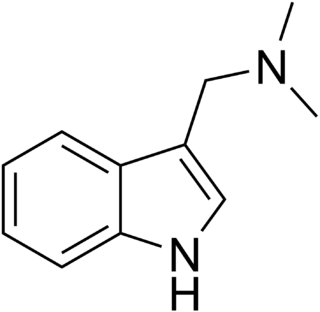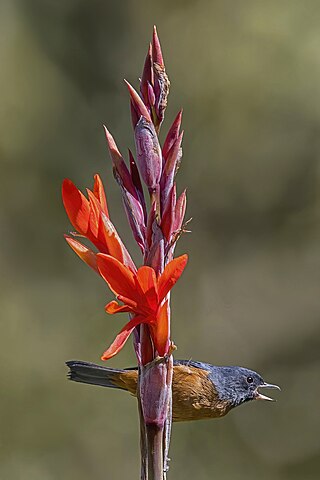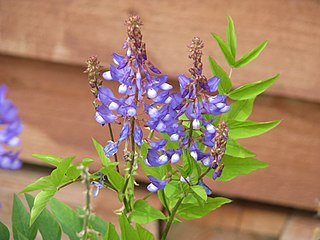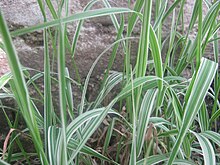
N,N-Dimethyltryptamine is a substituted tryptamine that occurs in many plants and animals, including humans, and which is both a derivative and a structural analog of tryptamine. DMT is used as a psychedelic drug and prepared by various cultures for ritual purposes as an entheogen.

Reed is a common name for several tall, grass-like plants of wetlands.

Phalaris is a genus of grasses. Various species of Phalaris grow on every continent except Antarctica. They can be found in a broad range of habitats from below sea level to thousands of feet above sea level and from wet marshy areas to dry places. P. arundinacea and P. aquatica are sometimes invasive species in wetlands.

Ornamental grasses are grasses grown as ornamental plants. Ornamental grasses are popular in many colder hardiness zones for their resilience to cold temperatures and aesthetic value throughout fall and winter seasons.

A reedbed or reed bed is a natural habitat found in floodplains, waterlogged depressions and estuaries. Reedbeds are part of a succession from young reeds colonising open water or wet ground through a gradation of increasingly dry ground. As reedbeds age, they build up a considerable litter layer that eventually rises above the water level and that ultimately provides opportunities in the form of new areas for larger terrestrial plants such as shrubs and trees to colonise.

Gramine is a naturally occurring indole alkaloid present in several plant species. Gramine may play a defensive role in these plants, since it is toxic to many organisms.

Canary grass is a plant, Phalaris canariensis, belonging to the family Poaceae. Originally a native of the Mediterranean region, it is now grown commercially in several parts of the world for birdseed.

Canna indica, commonly known as Indian shot, African arrowroot, edible canna, purple arrowroot, Sierra Leone arrowroot, is a plant species in the family Cannaceae. It is native to much of South America, Central America, the West Indies, and Mexico. It is also naturalized in the southeastern United States, and much of Europe, sub-Saharan Africa, Southeast Asia, and Oceania.

Phalaris aquatica, known by the common names bulbous canary-grass and Harding grass, is a species of grass in the genus Phalaris of the family Poaceae.

Arundo donax is a tall perennial cane. It is one of several so-called reed species. It has several common names including giant cane, elephant grass, carrizo, arundo, Spanish cane, Colorado river reed, wild cane, and giant reed. Arundo and donax are respectively the old Latin and Greek names for reed.

Hordenine is an alkaloid of the phenethylamine class that occurs naturally in a variety of plants, taking its name from one of the most common, barley. Chemically, hordenine is the N-methyl derivative of N-methyltyramine, and the N,N-dimethyl derivative of the well-known biogenic amine tyramine, from which it is biosynthetically derived and with which it shares some pharmacological properties. As of September 2012, hordenine is widely sold as an ingredient of nutritional supplements, with the claims that it is a stimulant of the central nervous system, and has the ability to promote weight loss by enhancing metabolism. In experimental animals, given sufficiently large doses parenterally, hordenine does produce an increase in blood pressure, as well as other disturbances of the cardiovascular, respiratory, and nervous systems. These effects are generally not reproduced by oral administration of the drug in test animals, and virtually no scientific reports of the effects of hordenine in human beings have been published.

Indole alkaloids are a class of alkaloids containing a structural moiety of indole; many indole alkaloids also include isoprene groups and are thus called terpene indole or secologanin tryptamine alkaloids. Containing more than 4100 known different compounds, it is one of the largest classes of alkaloids. Many of them possess significant physiological activity and some of them are used in medicine. The amino acid tryptophan is the biochemical precursor of indole alkaloids.

Phalaris brachystachys, the confused canary-grass or shortspike canarygrass, is an annual grass with growth habits and cultural requirements similar to Phalaris aquatica. It is native to the Mediterranean region. It grows most actively during the spring and fall, while resting during the heat of midsummer and the short cool days of winter. It also must be protected from heavy freezes.

5-MeO-NMT (5-methoxy-N-methyltryptamine) is an organic chemical compound, being the 5-methoxy analog of N-methyltryptamine (NMT). It was first isolated from Phalaris arundinacea. It has also been synthesized by Alexander Shulgin and reported in his book TiHKAL. Like other members of the N-methyltryptamine family of compounds, 5-MeO-NMT is believed to produce few or no psychedelic effects, although very little data exists about its pharmacological properties or toxicity.

Festuca arundinacea (syn., Schedonorus arundinaceus and Lolium arundinaceum) is a species of grass commonly known as tall fescue. It is a cool-season perennial C3 species of bunchgrass native to Europe. It is an important forage grass throughout Europe, and many cultivars have been used in agriculture. It is also an ornamental grass in gardens, and a phytoremediation plant.

Paspalum vaginatum is a species of grass known by many names, including seashore paspalum, biscuit grass, saltwater couch, silt grass, and swamp couch. It is native to the Americas, where it grows in tropical and subtropical regions. It is found throughout the other tropical areas of the world, where it is an introduced species and sometimes an invasive weed. It is also cultivated as a turfgrass in many places.

Galega orientalis is a species of flowering plant in the Fabaceae, the legume family. It is known commonly as fodder galega and eastern galega. It is cultivated as a fodder and forage for livestock.

Sparganium americanum, American bur-reed, is a perennial plant found in the United States of America and Canada. Though this species resembles a grass, it is a type of bur-reed. This species is important for conservation purposes because it has the ability to remove nitrogen and phosphorus runoff from water, like many other wetland species. By doing this, it protects waterways from excess nitrogen which can cause eutrophication. This increased nitrogen is especially a problem during the farmers’ growing season. During this same time frame the S. americanum is growing and taking up nitrogen.

The Qualicum National Wildlife Area (NWA) was officially established in 1977, under the Canada Wildlife Act (1973). The primary objective of the Qualicum NWA was to conserve crucial habitats for migratory birds and various other species.




















